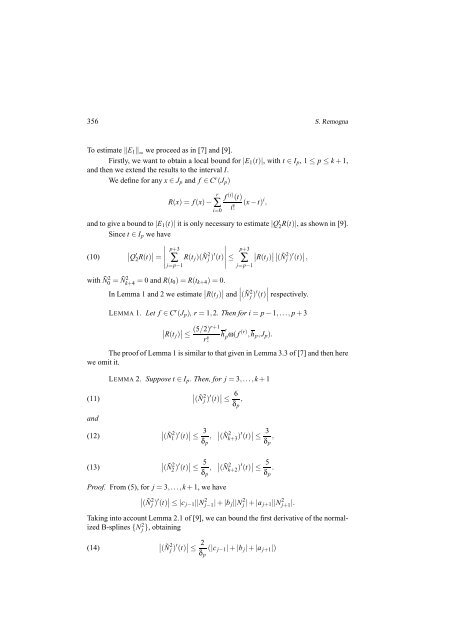Pseudo-spectral derivative of quadratic quasi-interpolant splines
Pseudo-spectral derivative of quadratic quasi-interpolant splines
Pseudo-spectral derivative of quadratic quasi-interpolant splines
You also want an ePaper? Increase the reach of your titles
YUMPU automatically turns print PDFs into web optimized ePapers that Google loves.
356 S. Remogna<br />
To estimate‖E 1 ‖ ∞ we proceed as in [7] and [9].<br />
Firstly, we want to obtain a local bound for |E 1 (t)|, with t ∈ I p , 1≤ p≤k+ 1,<br />
and then we extend the results to the interval I.<br />
We define for any x∈J p and f ∈ C r (J p )<br />
R(x)= f(x)−<br />
r<br />
∑<br />
i=0<br />
f (i) (t)<br />
(x− t) i ,<br />
i!<br />
and to give a bound to|E 1 (t)| it is only necessary to estimate|Q ′ 2R(t)|, as shown in [9].<br />
Since t ∈ I p we have<br />
(10)<br />
∣ Q<br />
′<br />
2 R(t) ∣ ∣ ∣∣∣∣ p+3<br />
= ∑ R(t j )(Ñ 2 p+3<br />
j )′ (t)<br />
∣ ≤ ∑<br />
j=p−1<br />
j=p−1<br />
∣ R(t j ) ∣ ∣ ∣ ∣ (Ñ 2 j )′ (t) ∣ ∣ ,<br />
with Ñ0 2 = Ñ2 k+4 = 0 and R(t 0)=R(t k+4 )=0.<br />
In Lemma 1 and 2 we estimate ∣ R(t j ) ∣ ∣ ∣∣(Ñ and 2 j )′ (t) ∣ respectively.<br />
LEMMA 1. Let f ∈ C r (J p ), r=1,2. Then for i= p−1,..., p+3<br />
∣ R(t j ) ∣ (5/2) r+1<br />
≤ h r p<br />
r!<br />
ω( f(r) ,h p ,J p ).<br />
The pro<strong>of</strong> <strong>of</strong> Lemma 1 is similar to that given in Lemma 3.3 <strong>of</strong> [7] and then here<br />
we omit it.<br />
(11)<br />
and<br />
(12)<br />
(13)<br />
LEMMA 2. Suppose t ∈ I p . Then, for j = 3,...,k+1<br />
∣ (Ñ 2 1 )′ (t) ∣ ∣ ≤<br />
3<br />
δ p<br />
,<br />
∣ (Ñ 2 2 )′ (t) ∣ ∣ ≤<br />
5<br />
δ p<br />
,<br />
∣ (Ñ 2 j )′ (t) ∣ ∣ ≤<br />
6<br />
δ p<br />
,<br />
∣ (Ñ 2 k+3 )′ (t) ∣ ∣ ≤<br />
3<br />
δ p<br />
,<br />
∣ (Ñ 2 k+2 )′ (t) ∣ ∣ ≤<br />
5<br />
δ p<br />
.<br />
Pro<strong>of</strong>. From (5), for j = 3,...,k+1, we have<br />
∣ (Ñ 2 j) ′ (t) ∣ ∣ ≤|c j−1 ||N 2 j−1|+|b j ||N 2 j|+|a j+1 ||N 2 j+1|.<br />
Taking into account Lemma 2.1 <strong>of</strong> [9], we can bound the first <strong>derivative</strong> <strong>of</strong> the normalized<br />
B-<strong>splines</strong>{N 2 j }, obtaining<br />
(14)<br />
∣<br />
∣(Ñ 2 j )′ (t) ∣ ∣≤ 2 δ p<br />
(|c j−1 |+|b j |+|a j+1 |)














